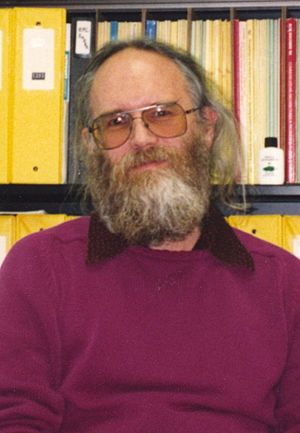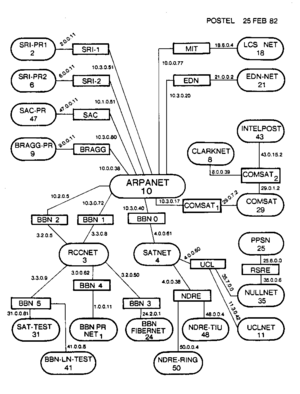Jon Postel facts for kids
Quick facts for kids
Jon Postel
|
|
|---|---|
 |
|
| Born | August 6, 1943 Altadena, California, U.S.
|
| Died | October 16, 1998 (aged 55) Santa Monica, California, U.S.
|
| Alma mater | UCLA |
| Known for | Request for Comment Internet Assigned Numbers Authority Postel's Law |
| Awards | ACM SIGCOMM Award (1997), ITU Silver Medal (1998), ISOC Jonathan B. Postel Service Award (1999, posthumous) |
| Scientific career | |
| Fields | Computer science |
| Doctoral advisor | Dave Farber |
| Influenced | Tim Berners-Lee |
Jonathan Bruce Postel (born August 6, 1943 – died October 16, 1998) was an American computer scientist. He helped a lot in making the Internet what it is today. He was especially important for setting up the rules and standards that the Internet uses.
Jon Postel is best known for being the editor of the Request for Comment (RFC) documents. These are like instruction manuals for how the Internet works. He also helped create the Simple Mail Transfer Protocol (SMTP), which is used for sending emails. Until he passed away, he managed the Internet Assigned Numbers Authority (IANA). This group gives out unique numbers and names needed for the Internet to run smoothly.
Some people called him the "god of the Internet" because of his huge influence. But Jon Postel himself said that the Internet works because many people cooperate.
Contents
Jon Postel's Early Life and Education
Jon Postel went to Van Nuys High School. Then, he studied at UCLA, a university in California. He earned his bachelor's degree in Engineering in 1966. He also got his master's degree in 1968.
In 1974, he finished his Ph.D. in computer science at UCLA. His professor, Dave Farber, was his advisor for his Ph.D. work.
Building the Internet: Jon Postel's Work
Jon Postel started working at UCLA in December 1969. He was part of the early team that built the ARPANET. This was an early version of the Internet.
He helped create the system for Internet domain names. These are names like "google.com" or "wikipedia.org". He also encouraged Vint Cerf and Bob Kahn to create new rules for sending data between different computer networks. These rules are now called the Internet protocol suite.
Jon Postel worked with Vint Cerf and Steve Crocker to put many of the ARPANET rules into action. Vint Cerf later became a main designer of the TCP/IP standard. This standard works well because of a rule often called Postel's Law.
In 1977, Jon Postel joined the Information Sciences Institute at the University of Southern California. He worked there as a research scientist.
The RFC Editor
Jon Postel was the editor for the RFC documents from 1969 until he died. He wrote or edited more than 200 important RFCs. These documents explain how the Internet's basic rules work. For example, RFC 791, RFC 792, and RFC 793 describe the main parts of the Internet protocol suite. He also wrote RFC 2223, which gives Instructions to RFC Authors.
Between 1982 and 1984, Postel helped write the RFCs that became the basis for today's DNS (Domain Name System). DNS helps turn website names into computer addresses.
Other Important Roles
Jon Postel was part of the Internet Architecture Board for many years. This group helps guide the Internet's development. He was also the first director of the Internet Assigned Numbers Authority (IANA). IANA is in charge of giving out unique numbers and names that computers use to find each other on the Internet.
He was the first member of the Internet Society. This group helps make sure the Internet stays open and available to everyone. He also managed the .us Top-Level Domain, which is for websites in the United States.
All these important jobs were things he did in addition to his main work. His main job was leading the Computer Networks Division at the Information Sciences Institute.
Jon Postel's Passing
On October 16, 1998, Jon Postel passed away in Los Angeles. He had complications after heart surgery. He was recovering from an operation to fix a heart valve.
Jon Postel's Lasting Impact
Jon Postel's work was very important for building the Internet. After he died, a special document called RFC2468 "I Remember IANA" was written by Vint Cerf. It honors Jon Postel's life and work.
The Postel Center at the Information Sciences Institute at the University of Southern California is named after him. There is also an annual Postel Award given in his honor. In 2012, Jon Postel was added to the Internet Hall of Fame. This recognizes people who have made major contributions to the Internet.
Another tribute, RFC2441, was written by Danny Cohen. It is called "Working with Jon: Tribute delivered at UCLA, October 30, 1998."
Postel's Law: Be Flexible!
One of Jon Postel's most famous ideas is often called Postel's law. It comes from an early Internet document, RFC760. This law says that computer programs should be "conservative in what they send, and liberal in what they accept."
This means that when a computer sends information, it should follow the rules very strictly. But when it receives information, it should be flexible and try to understand it, even if it's not perfectly formatted. This helps different computer systems work together smoothly, even if they have small differences.
See also
 In Spanish: Jon Postel para niños
In Spanish: Jon Postel para niños
- Computer Networks: The Heralds of Resource Sharing (1972 documentary w/Postel cameo)
- History of the Internet
- Jonathan B. Postel Service Award
- STD 8


